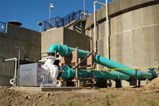Mixing Comparison: Hydraulic Or Gas

Fairfield-Suisun Sewer District (FSSD) in California installed a Vaughan Rotamix® hydraulic mixing system next to an identical anaerobic digester with a 7-year-old gas mixing system. Rotamix® installation was completed in Sept, 2010. This opportunity allowed the District to directly compare Rotamix vs. gas mixing in their very well instrumented digesters, which handle predominantly primary and thickened waste activated sludge. The digesters are identical 95 ft (29m) dia, 1.76 million gallons (500 m3) conical floor units.
Various parameters in both digesters have been carefully monitored for more than 8 months, from Feb. 21, 2011 to Nov. 2, 2011. Rotamix® uses a 100-HP chopper pump pumping into a total of 10 mixing nozzles arrayed on the floor of Digester 1, while the gas mixing system uses a 60 HP compressor sending compressed biogas to floor diffuser nozzles in Digester 2. The Rotamix® nozzles as installed on the floor of Digester 1
Over the course of 8 months the plant has experimented with running the Vaughan Rotamix® mixing system on various reduced duty cycles to save on power costs: first 3 hours on, 1 hour off,later 4 hours on, 2 hours off, and then more recently, 3 hours on, 3 hours off (50% duty cycle). The FSSD operators have found no degradation in performance of the Rotamix® system by varying duty cycle from 100% to the current 50% operating scheme. However, the 50% duty cycle cut the Rotamix® power usage in half, reducing Digester 1 mixing system power demand to 12% below that of Digester 2. Gas mixing systems are typically operated continuously.
Get unlimited access to:
Enter your credentials below to log in. Not yet a member of Water Online? Subscribe today.
